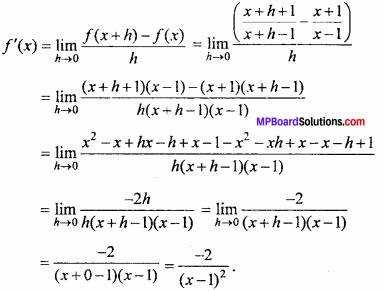MP Board Class 11th Maths Important Questions Chapter 13 Limits and Derivatives
Limits and Derivatives Important Questions
Limits and Derivatives Short Answer Type Questions
Evaluate the following limits :
Question 1.
![]()
Solution:
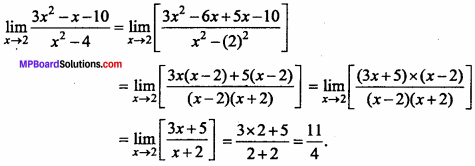
Question 2.
![]()
Solution:
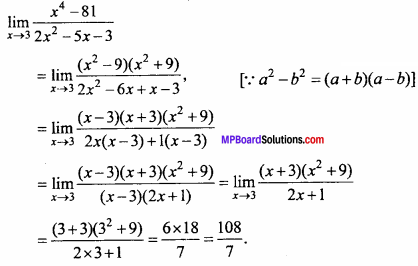
Question 3.
![]()
Solution:
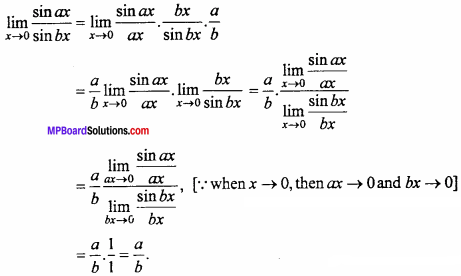
Question 4.

Solution:
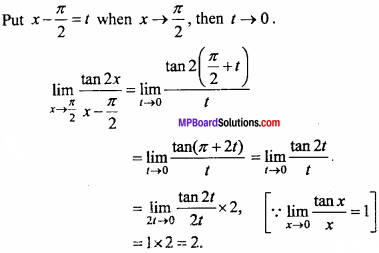
Question 5.
![]()
Solution:
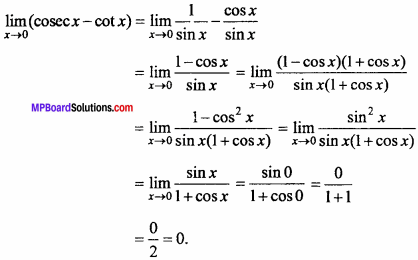
Question 6.
![]()
Solution:
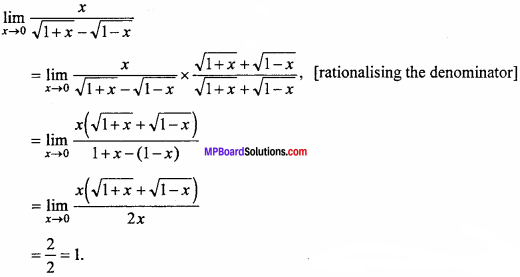
Question 7.
![]()
Solution:
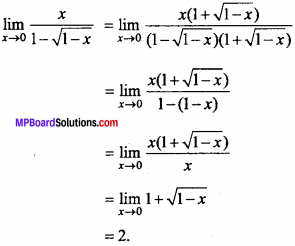
Question 8.

Solution:
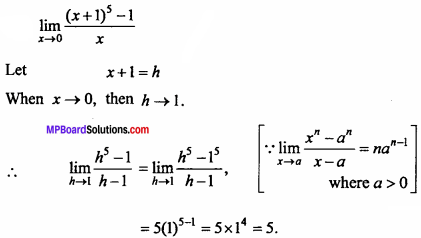
Question 9.
If  = 405, then find the value of n.
= 405, then find the value of n.
Solution:
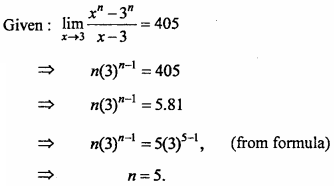
Question 10.
Find the value of :
![]()
Solution:
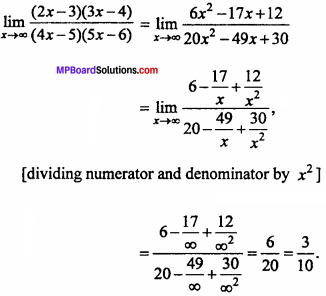
Question 11.
![]()
Solution:
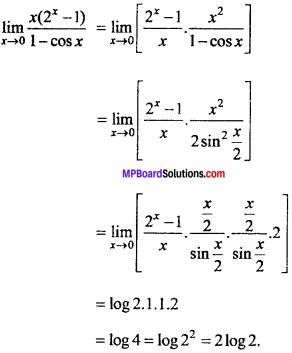
Question 12.
If y = ex cos x, then find the value of \(\frac { dy }{ dx }\)
Solution:
y = ex.cos x
I II
\(\frac { dy }{ dx }\) = \(\frac { d }{ dx }\)(ex.cos x)
= ex.\(\frac { d }{ dx }\)cos x + cos x\(\frac { d }{ dx }\)ex
= ex( – sin x) + cos x\(\frac { d }{ dx }\)ex
= ex[cos x – sin x].
Question 13.
If y = ex cos x, then find the value of \(\frac { dy }{ dx }\)
Solution:
y = ex.sin x
I II
\(\frac { dy }{ dx }\) = \(\frac { d }{ dx }\)(ex.sin x)
= ex.\(\frac { d }{ dx }\)sin x + sin x\(\frac { d }{ dx }\)ex
= excos x + x.ex
= ex(cos x + sin x).
![]()
Question 14.
Differentiate sin(x + a) w.r.t. x.
Solution:
Let y = sin(x + a)
y = sin x cos a + cos x sin a
∴\(\frac { dy }{ dx }\) = \(\frac { d }{ dx }\)(sin x cos a + cos x sin a)
= cos a\(\frac { d }{ dx }\) sin x + sin\(\frac { d }{ dx }\)cos x
= cos a cos x – sin a sin x
⇒ \(\frac { dy }{ dx }\) = cos(x + a).
Question 15.
Differentiate cosecx.cotx w.r.t. x.
Solution:
Let y = cosec x. cot x
⇒ \(\frac { dy }{ dx }\) = \(\frac { d }{ dx }\)[cosec x. cot x]
⇒ \(\frac { dy }{ dx }\) = cot x\(\frac { d }{ dx }\) cosec x + cosec x\(\frac { d }{ dx }\) cot x
= – cot xcosec x cot x – cosec x.cosec2 x
\(\frac { dy }{ dx }\) = – cosec x[cot2 x + cosec2 x].
Question 16.
Differentiate \(\frac { cos x }{ 1 + sin x }\) w.r.t. x.
Solution:
Let y = \(\frac { cos x }{ 1 + sin x }\)
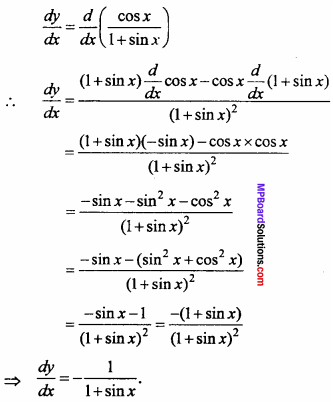
Question 17.
Differentiate \(\frac { sec c – 1 }{ sec x + 1 }\) w.r.t. x.
Solution:
Let y = \(\frac { sec c – 1 }{ sec x + 1 }\)
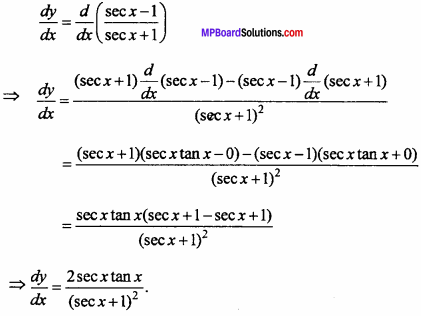
Question 18.
Differentiate sinn x w.r.t. x.
Solution:
Let y = sinn x
\(\frac { dy }{ dx }\) = \(\frac { d }{ dx }\)(sinn x )
Put sin x = t,
\(\frac { dy }{ dx }\) = \(\frac { d }{ dx }\)tn = \(\frac { d }{ dt }\)tn. \(\frac { dt }{ dx }\) = n sinn – 1\(\frac { d }{ dx }\)(sin x)
⇒ \(\frac { dy }{ dx }\) = n sinn – 1x cos x.
Limits and Derivatives Long Answer Type Questions
Question 1.
Let f(x) =
 , then find the value of a and b.
, then find the value of a and b.
Solution:
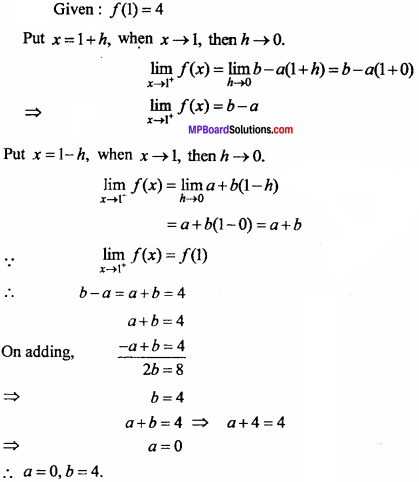
Question 2.
Find the value of ![]() , where
, where

Solution:
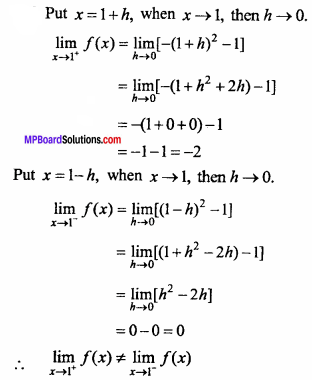
Question 3.
f(x) is defined such that
 and
and ![]() is exist x = 2, then find the value of k.
is exist x = 2, then find the value of k.
Solution:
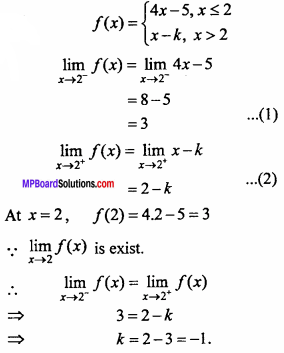
Question 4.
If the function f(x) satisfies![]() = π, then find the value of
= π, then find the value of ![]()
Solution:
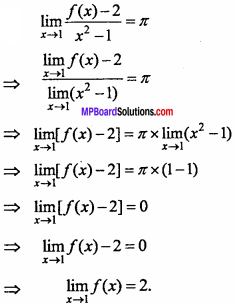
Question 5.
Find the differential coefficient of the following functions by using first principle method :
(i) sin(x + 1), (ii) cos(x – \(\frac { π }{ 8 }\),
Solution:
(i) Let f(x) = sin(x + 1)
∴ f(x + h) = sin[x + h + 1]
By definition of first principle,
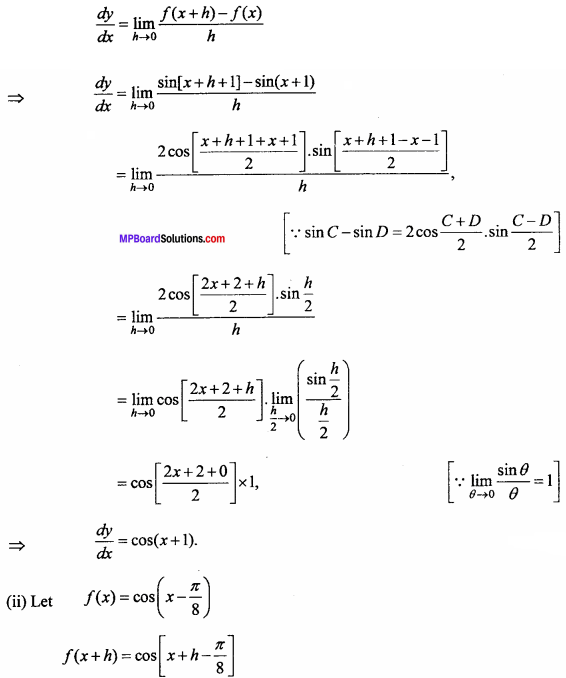
By definition of first principle,
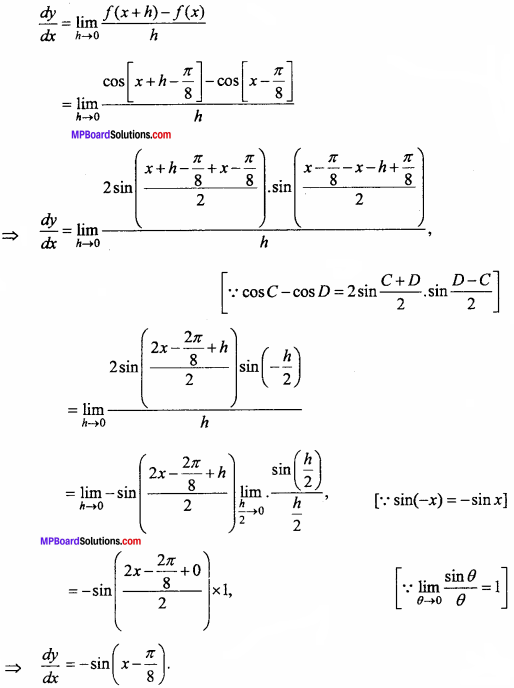
Find the differential coefficient of the following functions
Question 6.
(ax2 + sin x)(p + q cos x). (NCERT)
Solution:
Let y = (ax2 + sin x)(p + q cos x).
∴ \(\frac { dy }{ dx }\) = \(\frac { d }{ dx }\)[(ax2 + sin x)(p + q cos x)]
⇒ \(\frac { dy }{ dx }\) = (p + q cos x)\(\frac { d }{ dx }\)(ax2 + sin x) + (ax2 + sin x)\(\frac { d }{ dx }\) (p + q cos x)
⇒ \(\frac { dy }{ dx }\) = (p + q cos x)(2a + cos x) + (ax2 + sin x)(0 – q sin x)
⇒ \(\frac { dy }{ dx }\) = – q sin x(ax2 + sin x) + (p + q cos x)(2a + cos x)
![]()
Question 7.
(x + cos x)(x – tan x) (NCERT)
Solution:
Let y = (x + cos x)(x – tan x)
∴ \(\frac { dy }{ dx }\) = \(\frac { d }{ dx }\)[(x + cos x)(x – tan x)]
⇒ \(\frac { dy }{ dx }\) = (x – tan x)\(\frac { d }{ dx }\)(x + cos x) + (x + cos x)\(\frac { d }{ dx }\)(x – tan x)
⇒ \(\frac { dy }{ dx }\) = (x – tan x)(1 – sinx) + (x + cos x)(1 – sec2 x)
= (x – tan x)(1 – sinx) + (x + cos x)(sec2 x – 1)
⇒ \(\frac { dy }{ dx }\) = (x – tan x)(1 – sinx) – tan2 x(x + cos x)
Question 8.
\(\frac { 4x + 5sin x }{ 3x + 7 cos x}\)
Solution:
Let y = \(\frac { 4x + 5sin x }{ 3x + 7 cos x}\)
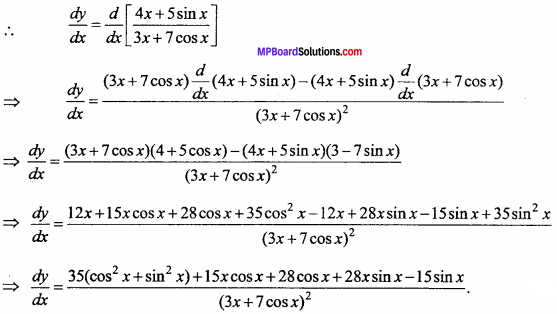
Question 9.
\(\frac{x^{2} \cos \frac{\pi}{4}}{\sin x}\)
Solution:
Let y = \(\frac{x^{2} \cos \frac{\pi}{4}}{\sin x}\)
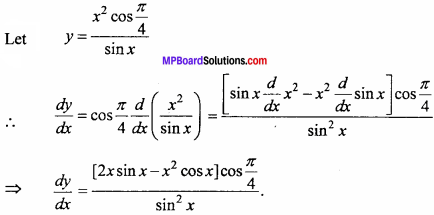
Question 10.
\(\frac { x }{ 1 + tan x}\)
Solution:
Let y = \(\frac { x }{ 1 + tan x}\)
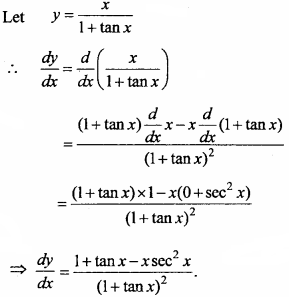
Question 11.
Find the differential coefficient of \(\frac { sec x – 1 }{ sec x + 1}\)
Solution:
Let y = \(\frac { sec x – 1 }{ sec x + 1}\)
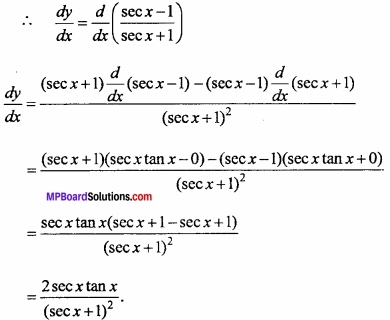
Question 12.
If y = \(\frac { x }{ x + 4 }\), then prove that:
x\(\frac { dy }{ dx}\) = y(1 – y)
Solution:
Given : y = \(\frac { x }{ x + 4 }\)
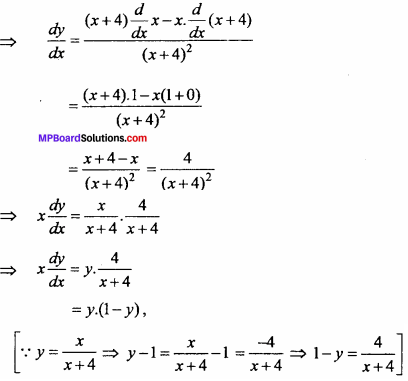
Question 13.
If y = \(\sqrt {x}\) + \(\frac{1}{\sqrt{x}}\), then prove that : 2x\(\frac { dy }{ dx}\) + y – 2 \(\sqrt {x}\) = 0
Solution:
Given : y = \(\sqrt {x}\) + \(\frac{1}{\sqrt{x}}\)
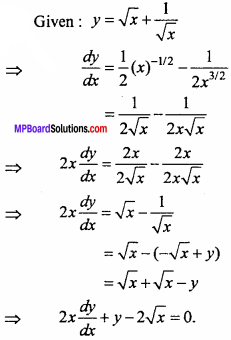
Question 14.
Find the differential coefficient of \(\frac { sin(x + a) }{ cos x }\)
Solution:
Let y = \(\frac { sin(x + a) }{ cos x }\)
⇒ y = \(\frac { sin x + cos a + cos x sin a }{ cos x }\)
⇒ y = \(\frac { sin x + cos a }{ cos x }\) + \(\frac { cos x + sin a }{ cos x }\)
⇒ y = cos a tan x + sin a
∴ \(\frac { dy }{ dx}\) = \(\frac { d }{ dx}\)(cos a tan x + sin a)
= cos a \(\frac { d }{ dx}\) tan x + \(\frac { d }{ dx}\) sin a
= cos a x sec2 x + 0
= sec2x. cos a.
![]()
Question 15.
If f(x) = \(\frac { { x }^{ 100 } }{ 100 } +\frac { { x }^{ 99 } }{ 100 }\)+……..\(\frac { { x }^{ 2 } }{ 2 }\) + x +1, then prove that:
f'(1) = 100 f'(0). (NCERT)
Solution:
Put x = 1, we get
f'(1) = 1 + 1 + ………. 1 + 1 (100 times)
f’(1) = 100 …. (1)
Put x = 0, we get
f'(0) = 0 + 0 + ……… 0 + 1
f’(0) = 1 …. (2)
From equation (1) and (2),
f'(1) = 100 f'(0).
Question 16.
Find the differential coefficient of cos x by first principle method. (NCERT)
Solution:
Let f(x) = cosx
∴ f(x + h) = cos(x + h)
By definition of first principle
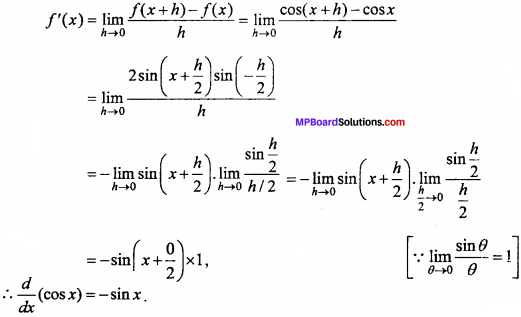
Question 17.
Find the differential coefficient of f(x) = \(\frac { x + 1 }{ x – 1 }\) by first principle method.
Solution:
Given : f(x) = \(\frac { x + 1 }{ x – 1 }\)
f(x + h) = \(\frac { x + h + 1}{ x + h – 1 }\)
By definition of first principle,
